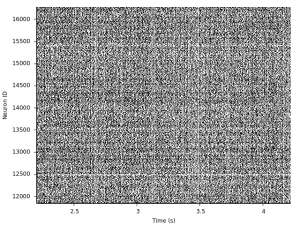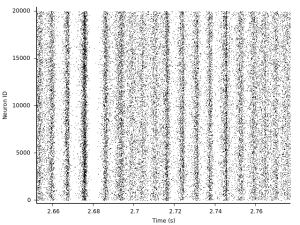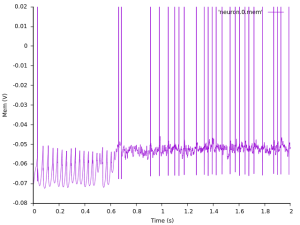This is an old revision of the document!
Table of Contents
Tutorial 2: Balanced network
Here you will learn to wire up a simple balanced network. This assumes that you already know the basics explained in Tutorial 1.
Setting up neural populations
A balanced network has an excitatory and an inhibitory population which we model as distinct NeuronGroups. Moreover, we will include some external Poisson input to jump start the network and keep activity alive.
Copy the basic Auryn simulation skeleton from Tutorial 1 to a new sim_mytute2.cpp file. In that bare bones simulation, let's first set up the network neurons:
int nb_exc_neurons = 20000; int nb_inh_neurons = nb_exc_neurons/4; IFGroup * neurons_exc = new IFGroup(nb_exc_neurons); neurons_exc->set_name("exc neurons"); IFGroup * neurons_inh = new IFGroup(nb_inh_neurons); neurons_inh->set_tau_mem(5e-3); neurons_inh->set_name("inh neurons");
The above code snipped initializes an excitatory population (neurons_exc) with 20000 neurons and an inhibitory population which is one quarter in size. Here were are using IFGroup one of Auryn's standard neuron models. These neurons have conductance based synapses with a fast and slow excitatory conductance. Moreover, the model has a relative refractory mechanism. Also note that we give the inhibitory neurons a membrane time constant of 5ms.
As before in Tutorial 1 we define Poisson input as a separate population:
int nb_input_neurons = 5000; float poisson_rate = 2.0; PoissonGroup * poisson = new PoissonGroup(nb_input_neurons,poisson_rate);
Connecting the network
Now let's connect these three populations. First the input:
float weight = 0.2; // conductance amplitude in units of leak conductance float sparseness = 0.05; // probability of connection SparseConnection * con_ext_exc = new SparseConnection(poisson,neurons_exc,weight,sparseness,GLUT);
And now the recurrent connctions:
float gamma = 4.0; SparseConnection * con_ee = new SparseConnection(neurons_exc,neurons_exc,weight,sparseness,GLUT); SparseConnection * con_ei = new SparseConnection(neurons_exc,neurons_inh,weight,sparseness,GLUT); SparseConnection * con_ie = new SparseConnection(neurons_inh,neurons_exc,gamma*weight,sparseness,GABA); SparseConnection * con_ii = new SparseConnection(neurons_inh,neurons_inh,gamma*weight,sparseness,GABA);
Note that we made inhibitory connections stronger by a factor of gamma = 4.0.
Set up monitors
Let's record spikes from all neurons and the membrane potential from neuron 0 in the excitatory population. To do that we set up the following monitors
SpikeMonitor * exc_spike_mon = new SpikeMonitor( neurons_exc, sys->fn("exc","ras") ); VoltageMonitor * voltage_mon = new VoltageMonitor( neurons_exc, 0, sys->fn("neuron","mem") ); voltage_mon->record_for(2);
With the last call we limit the recording time for the VoltageMonitor to 2 seconds. Because VoltageMonitor and StateMonitor have a default sampling interval of 0.1ms they quickly generate a lot of data. It's therefore advisable to limit the recording time to windows when you actually need it to speed up simulations and limit the use of disk space.
Running the simulation
To run the simulation for 10 seconds we simply add the run command:
sys->run(10);
That's it. You should now have a program which you can compile and run.
Assuming your simulation file was called sim_tutorial2.cpp and you have set up a Makefile as described here, you can simply enter this on your command line
$ make sim_tutorial2 && ./sim_tutorial
Visualizing the spikes
Running above code will generate the following files:
$ ls -ltrs | tail -n 4
912 -rwxrwxr-x 1 zenke zenke 931424 Sep 1 13:45 sim_tutorial2
4724 -rw-rw-r-- 1 zenke zenke 4835075 Sep 1 13:45 exc.0.ras
4 -rw-rw-r-- 1 zenke zenke 1077 Sep 1 13:45 sim_tutorial2.0.log
372 -rw-rw-r-- 1 zenke zenke 380022 Sep 1 13:45 neuron.0.mem
Let's take a look at the spikes (in the ras file first).
 That's a lot of spikes, but the image suggests that there is some synchrony going on at times, but there are also phases of asynchronous firing. Let's zoom in a bit more:
That's a lot of spikes, but the image suggests that there is some synchrony going on at times, but there are also phases of asynchronous firing. Let's zoom in a bit more:

Now let's have a look the membrane trace we recorded from one of our cells:
 After some initial burn in period of the network dynamics the neuron seems to start firing more irregularly.
After some initial burn in period of the network dynamics the neuron seems to start firing more irregularly.
